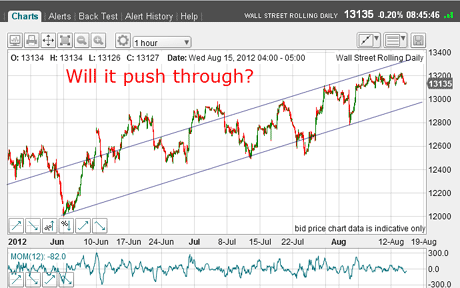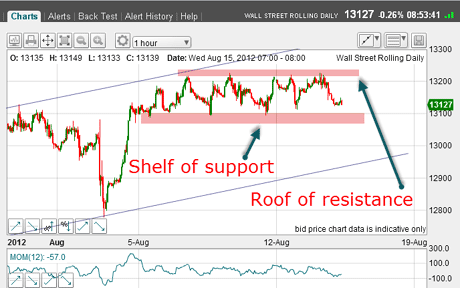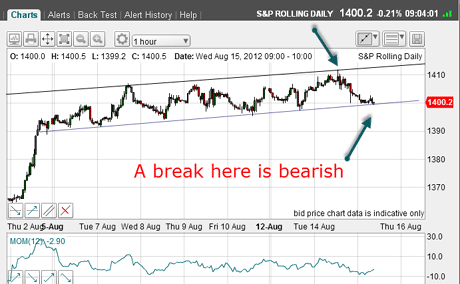Could the Dow be heading for a new yearly high?
The Dow Jones has been trading within a range lately. Any move out of it could be explosive, says John C Burford. So is it likely to be a fall, or up to a new high?
The question must be uppermost in the minds of many traders, as it is with me: could the Dow push through my tramline for a new yearly high? The market is only a hundred or so pips off making that high. And I find that startling.
Despite the well-known turmoil in the eurozone; the very weak economic recovery in the US with real estate still depressed; the marked slowdown in China; not to mention the gargantuan mountains of debt almost everywhere you look (except for many cash-rich large cap companies); the markets are knocking on the door to new highs.
How is this possible? Is the stock market signalling full economic recovery ahead with the cash pile of companies being put to productive use? We know that markets tend to be one step (or more) ahead of events, so this is entirely possible.
MoneyWeek
Subscribe to MoneyWeek today and get your first six magazine issues absolutely FREE

Sign up to Money Morning
Don't miss the latest investment and personal finances news, market analysis, plus money-saving tips with our free twice-daily newsletter
Don't miss the latest investment and personal finances news, market analysis, plus money-saving tips with our free twice-daily newsletter
Or is it that markets have got it all wrong and are buoyed up by baseless hope that more quantitative easing (QE) will keep the rally alive?
How to keep track of sentiment
These forces are responsible for the deep polarisation in today's markets.
One way I keep track of sentiment is via the AAII https://www.aaii.com/ survey of mom and pop' US investors and this is the latest result:
| Week ending 8/8 | 36% | 27% | 36% |
| Change in week | 6% | -8% | 1% |
| Long-term average | 39% | 30% | 31% |
There has been another very large swing to the bullish camp with a net move of 14%, following the rally to the 13,200 area. Isn't it wonderful what a sustained rally does to sentiment?
But even with this swing, the percentage of bulls still remains lower than the long-term average. As a measure of the confusion out there, the neutral camp is larger than the long-term average.
This is the process: As traders notice the market moving up, they become more bullish as more join the herd until the situation becomes unstable. I liken it to a ship where people rush to one side and then finally the last person capsizes it.
What does this tell us about the Dow?
Sadly, I have found no mathematical measure the tipping point of sentiment that can be applied universally. I have to make a judgment of when there are too many bulls and combine this with my trading methods.
But what I take from the AAII results is that the market may well be ready to turn.
I believe yesterday was significant in that the S&P poked to a new high, unaccompanied by the Dow.
So let's turn to the charts:

(Click on the chart for a larger version)
This is my tramline pair I have been using and the market is close to the upper line. The trading over the past few days has been confined to a trading range of about 100 pips or so, so let's take a close-up look:

(Click on the chart for a larger version)
The market has been trading between my roof of resistance' and the shelf of support' for over a week, providing much food for frustration to short-term traders. That is why I have been out of the market, waiting for signals.
And I may have one very soon! I mentioned the S&P making a new high yesterday here are my lovely tramlines on the S&P chart:

(Click on the chart for a larger version)
Yesterday's rally carried exactly to the upper line and is this morning challenging the lower one. A break here would be very significant and would point to the likely start of the move down I have been expecting.
Short-term traders may be lookingto short the S&P on this break, or in the case of the Dow, to place sell stops just below the shelf of support, or even upon a break in the S&P as trigger event.
How to prepare for a sharp move
On Monday, I discussed some of the Elliott wave implications of a possible upward break into new highs. Now if yesterday was indeed the top, I will breathe a sigh of relief, as that would keep intact my original Elliott wave labels for the Dow and keep my forecast for big moves down in place.
At some stage, the market will break out of its current range, and the move could be explosive. If so, then if without a position, jumping on board would be like trying to catch a tiger by the tail.
Trader tip: If you believe a sharp move is imminent, waiting for confirmation could lead you to take a position at the wrong time just before a large counter-trend move that could stop you out. We have all been in this situation. I like to take early positions often before I have the full facts and sometimes, I get stopped out a few times before getting it right.
A more conservative trader may wait for full confirmation and place much wider stops. It is horses for courses.
If you're a new reader, or need a reminder about some of the methods I refer to in my trades, then do have a look at my introductory videos:
The essentials of tramline trading
An introduction to Elliott wave theory
Advanced trading with Elliott waves
Don't miss my next trading insight. To receive all my spread betting blog posts by email, as soon as I've written them, just sign up here . If you have any queries regarding MoneyWeek Trader, please contact us here.
Get the latest financial news, insights and expert analysis from our award-winning MoneyWeek team, to help you understand what really matters when it comes to your finances.
John is is a British-born lapsed PhD physicist, who previously worked for Nasa on the Mars exploration team. He is a former commodity trading advisor with the US Commodities Futures Trading Commission, and worked in a boutique futures house in California in the 1980s.
He was a partner in one of the first futures newsletter advisory services, based in Washington DC, specialising in pork bellies and currencies. John is primarily a chart-reading trader, having cut his trading teeth in the days before PCs.
As well as his work in the financial world, he has launched, run and sold several 'real' businesses producing 'real' products.
-
 What are my retirement income options?
What are my retirement income options?We’re all told to save into a pension, but there’s widespread confusion about how to take an income from our savings and investments at retirement, a new study has found. We look at your retirement income options.
-
 UK interest rates: will the Bank of England lower rates?
UK interest rates: will the Bank of England lower rates?The Bank of England’s Monetary Policy Committee’s (MPC) final interest rates meeting of the year takes place tomorrow (18 December) and most experts expect a cut